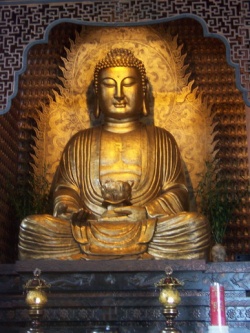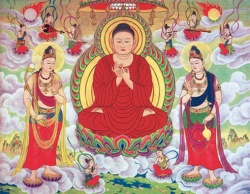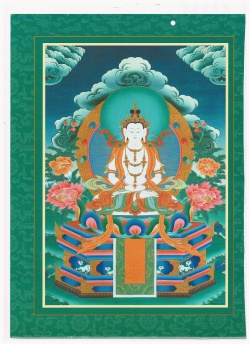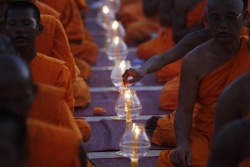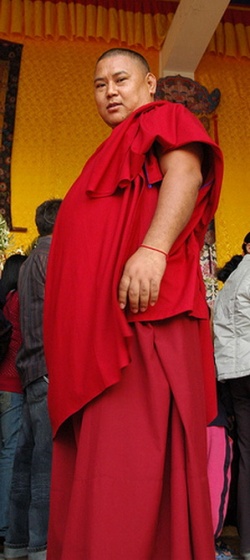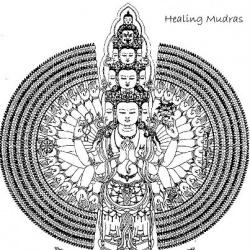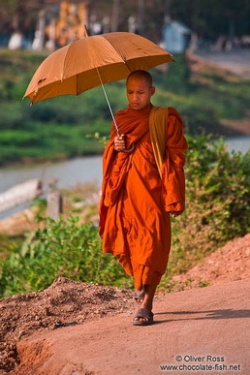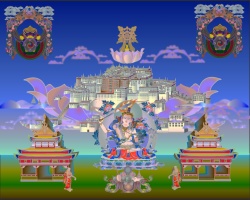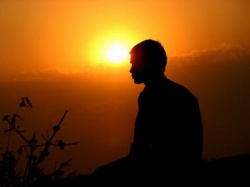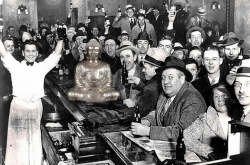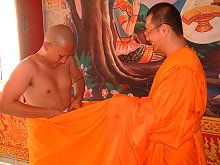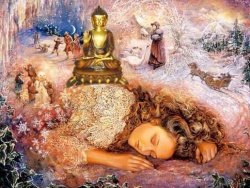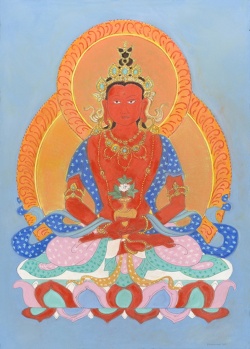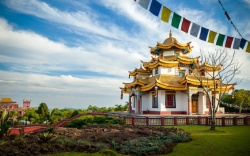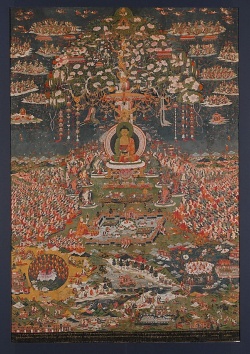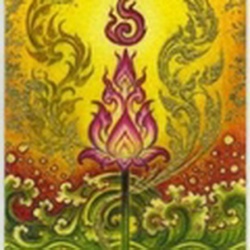Pure land
pure land
浄土 (Jpn jodo )
A Buddha's land. The term is contrasted with impure land, meaning the saha world, this world that is tainted with suffering and desire.
A pure land of a buddha is a place where there is no suffering. In some but not all pure lands, after taking birth, the practitioner receives teachings directly from the buddha of that pure land, actualizes the rest of the path and then becomes enlightened.
A Buddha's land is said to be blissful and free from impurity and is therefore called a pure land.
Buddhism sets forth two views concerning the relationship of the saha world and the pure land.
The first is that thepure land is another realm entirely, physically removed from the saha world. Examples of this view are belief in the Pure Emerald World of Medicine Master Buddha in the east, and in Amida Buddha's Pure Land of Perfect Bliss in the west.
(The term Pure Land in capitals generally indicates Amida's land.)
The second view, represented in the Lotus Sutra and the Vimalakirti Sutra, is that no pure land exists apart from the saha world: the saha world reveals either its pure aspect or impure aspect in response to the purity or impurity of the hearts and minds of those inhabiting it.
One with a pure heart thus dwells in a pure land here and now. Collectively, when people purify their hearts and minds, the society or world where they live becomes a pure land.
A Pure Land or Buddha Field, (Sanskrit: Buddhakṣetra) in Mahayana Buddhism (including Vajrayana), is the celestial realm or pure abode of a Buddha.
The various traditions that focus on Pure Lands have been given the nomenclature Pure Land Buddhism. Pure lands are also evident in the literature and traditions of Bön.
Pure Lands are Bardo experiences, in which one's own Wisdom manifests as such.
The Pure land tradition is one of the oldest and most influential in Chinese Buddhism. In Mahayana there are countless buddhas and pure lands in the universe.
Each pure land (also called buddharealm) is ruled over by a buddha.
For the pure land believers, these paradises are geographically localizable places of bliss; however, fundamentally they stand for aspects of the awakened state of mind, and the directions (east, west, etc.) have iconographical meanings.
However pure land generally guarantees no evil would exist, the people would be long-lived and would receive whatever they desired, and from where they might attain Nirvana, which is to be realized in the ensuring rebirth.
In addition, in a pure land, retrogression is no longer possible. But in the pure land Buddhism, the attainment of Nirvana is not the goal; it is rather to become reborn in the pure lands.
Among these many pure lands, the most important one is Sukhavati, the pure land of the west or the western paradise, ruled by Buddha Amitabha.
According to the Amitabha sutras, this pure land is full of lotus and the Amitabha Buddha uses lotus as vehicle to receive his adherents to this bliss world, thus this school is often called "the Lotus school".
The goal of the adherents of this school is to be reborn in the pure land of Buddha Amitabha.
As described in the sutra, Buddha Amitabha has made a vow to cause all beings to be reborn in his pure land Sukhavati.
Only a successful practice, which includes recitation and visualization as the external condition and total faithful devotion toward Amitabha as the inner condition, can guarantee the rebirth in this paradise.
Since its adherents rely upon the external help of Amitabha, the way of the Pure-land school is often regarded as the "faith path" or the "easy path".
The tradition of Pure-land practice can be traced back to the monk Hui-yuan.
In 402 A.D. Hui-yuan founded a 30 people group where monks and layman assembled in a temple and vowed to be reborn in the pure land before an image of the Buddha Amitabha. Hui-yuan is thus regarded as the first patriarch of this school.
The second patriarch Tan-luan (476-542) contributed considerably to the development of the Pure-land school.
He advocated the attainment of liberation in one life cycle is impossible without faith in the infinite power and compassion of Buddha Amitabha.
He rejected the "hard path" of the other schools which required many life cycles of practice to accumulate merit and fostered the "easy path", in which it is sufficient to recite Amitabha's name with complete devotion to be reborn in the pure land.
He further declared that even evil men were eligible for the pure land if they sincerely uttered "Namo Amida Buddha" (take refuge in the Buddha Amitabha).
It is believed that his following was largely among the laity, as there does not seem to have been any important monk followers of his own who established this tradition as an independent lineage.
Shan-tao (613-681) is considered the actual founder of the organized Pure-land school. He was the most prolific and successful patriarch of the school. He composed important commentaries on the Amitayurdhyana-sutra.
In his time the school experienced a major upsurge, since its practice, compared with that of other schools, seemed relatively easy.
PS: An eastern paradise is the pure land of Bhaishajua-guru Buddha (Medicine Guru Buddha).
The Abhirati paradise of Buddha Akshobhya is also in the east.
In the south is the paradise of buddha Ratnaketu, in the north that of Buddha Dundubhishvara.
A new pure land will be created by the future buddha Maitreya, who presently still dwells in the Tushita Heaven.
They are the hope of believers who wish to be reborn in them. The decisive factor is not their good karma but rather the aid of a given buddha, who has taken the vow to help all those to rebirth in his pure land turn to him in faith.
Discussion
In Mahayana Sutras, there are many pure lands. Boddhisatvas, such as Avalokitesvara and Manjusri, would have their pure lands after they attain Buddhahood.
In the Lotus Sutra, Buddha followers such as Sariputta, Mahākāśyapa, Subhuti, Moggallana and Rahula would also have their pure lands.
The relative time of pure lands may be different. A day in a pure land may be the same duration as years in another.
Pure land systems of devotion may be reconciled within the larger system of Buddhism as 'compassionate' (Sanskrit: karuna) upaya, often advocated for the less philosophically or intellectually inclined. Though this is not a definitive characteristic.
Other concepts such as 'devotion, Faith and conviction' (Sanskrit: śraddhā) are essential to the Path as evidenced by Buddhavacana and many scholars, philosophers and learned people feel considerable devotion and Faith in their sadhana and commitments.
Pure lands have been documented as arising due to the intention and aspiration of a Bodhisattva such as the case of Amitabha, but other discourse has codified that they are entwined with 'emanation' (Sanskrit:
nirmana) and Sambhogakaya theory and are understood to manifest effortlessly and spontaneously due to other activities (Wylie: phrin las) of a Buddha, in suite with The Buddha's pure qualities (Wylie: yon tan) and mysteries of Body, speech and Mind.
In the latter effortless and spontaneous methodology, the Five Certainties/Five Excellences (Tibetan: nges-pa lnga), attributes of the Body of perfect rapture (Sanskrit: Sambhogakāya) play a role, namely,
those of the perfected: 'teacher' (Wylie: ston-pa), 'teaching' (Wylie: bstan-pa), 'retinue' (Wylie: 'khor), 'place' (Wylie: gnas) and 'time' (Wylie: dus).
Nakamura (1980, 1987: p. 207) establishes the Dharmic grounding of the padma imagery of the field which is evident iconographically, as well as in motif and metaphor:
- The descriptions of Pure Land in Pure Land Sutras were greatly influenced by Brahmin and Hindu ideas and the topological situation in India.
There was a process of the development of Lotus (padma)-symbolism in Pure Land Buddhism.
The final outcome of the Thought was as follows: the aspirants of Faith and assiduity are born transformed (anupapāduka) in the Lotus Flowers. But those with doubts are born into the Lotus-buds.
They stay in the calyx of a Lotus (garbhāvāsa) for five hundred years without seeing or hearing the Three Treasures. Within the closed Lotus-Flowers they enjoy pleasures as though they were playing in a garden or palace.
Five Pure Abodes
Five Pure Abodes of the Form realms) (Wylie: gtsang-ma'i gnas lnga; Sanskrit: pañcaśuddhanivāsa)
- Avṛha (Sanskrit; Tibetan: མི་ཆེ་བ, Wylie: mi che ba)
- Atapa (Sanskrit; Tibetan: མི་གདུང་བ, Wylie: mi gdung ba)
- Sudṛśa (Sanskrit; Tibetan: གྱ་ནོམ་སྣང་བ, Wylie: gya nom snang ba)
- Sudarśana (Sanskrit; Tibetan: ཤིན་ཏུ་མཐོང, Wylie: shin tu mthong)
- Akaniṣṭa (Sanskrit; Tibetan: འོག་མིན, Wylie: 'og min)
The Source
Very important to all pure abodes is the 'Source' (Tibetan: ཆོས་འབྱུང, Wylie: cho 'byung; Sanskrit: dharmodaya) from which they dwell and which supports them, the 'Wellspring' of myriad fonts as emergent.
It may beunderstood as an interface, portal or epiphany between the Dharmakaya and the Sambhogakaya.
It is seminal in the establishment of mandalas governing the outer, inner or secret dimensions.
It is the opening and Consecration of the Sacred Space which enfolds and supports the expanse of the pure abode.
In iconography it is represented by the six-pointed star, the two interlocking offset equilateral triangles that Form a symmetry.
This is the 'sanctum sanctorum' (Sanskrit: garbha gṛha).
It later developed into the primordial purity of the Lotus which supports the Mandala, Thangka or the murti of the deity.
In temple siting it is the Power place or 'spirit of place' that was augured or divined in the sacred geometry of 'geodesy' (Sanskrit: vāstu śāstra).
In yoga asana, the 'source' is Vajrasana, the 'seat of Enlightenment' the ancient name of Bodh Gaya and an alternate name for mahamudra or padmasana.
- "Source of Phenomena or qualities (chos 'byung, dharmodaya).
Pundarika defines dharmodaya as that from which Phenomena devoid of intrinsic nature originate. "Phenomena devoid of intrinsic nature" refers to the ten powers, the Four fearlessnesses, and the other 84,000 aspects of the teachings.
Their source, dharmodaya, is the pure realm, the abode of all Buddhas and Bodhisattvas, the place of bliss, the place of birth; it is not the place that discharges blood, urine, and regenerative fluids, i.e., the vagina. Source: Stainless Light, Toh. 1347, vol. Da, f237a3-5".
Śuddhāvāsa worlds
The Śuddhāvāsa (Pāli: Suddhāvāsa; Tib: gnas gtsang.ma) worlds, or "Pure Abodes", are distinct from the other worlds of the Rūpadhātu in that they do not house beings who have been born there through ordinary Merit or Meditative attainments,
but only those Anāgāmins ("Non-returners") who are already on the Path to Arhat-hood and who will attain Enlightenment directly from the Śuddhāvāsa worlds without being reborn in a lower plane (Anāgāmins can also be born on lower planes).
Every Śuddhāvāsa Deva is therefore a protector of Buddhism. (Brahma Sahampati, who appealed to the newly Enlightened Buddha to teach, was an Anagami from a previous Buddha).
Because a Śuddhāvāsa Deva will never be reborn outside the Śuddhāvāsa worlds, no Bodhisattva is ever born in these worlds, as a Bodhisattva must ultimately be reborn as a human being through their 'Compassion' (Sanskrit: Karuṇā) and Bodhisattva vows.
Sukhavati
Chagdud (1998, 2003: pp. 11–12), in discussing the Mindstream of Lokeṣvararāja (Japanese: Seijizaio Nyorai) that in fulfillment has come to be known as Amitābha:
- According to the Sutra known as the Rolling of Drums, countless eons ago there was a joyous kingdom whose sovereign had great devotion for The Buddha of that time, Lokesvararaja.
The king renounced his kingdom, became a Monk, and vowed to reach Enlightenment.
He expressed his Bodhicitta intention through forty-eight vows, and promised to refuse Buddhahood if any of these vows were not fulfilled.
With these words, the Earth trembled and Flowers rained down from the skies. Praises resounded and with them the prophecy that this Monk would surely become a Buddha. And so he did, as The Buddha Amitabha.
- In his lifetime as this Bodhisattva Monk, Amitabha saw that countless pure realms existed for realized ones who had been victorious over the Mind's delusions, but no such realm was accessible to those still struggling on the Path.
Among his forty-eight vows was the aspiration to create a pure realm for all those who heard his name, wished to attain that realm, established the roots of Virtue, and dedicated their Merit in order to be reborn there.
So powerful was his intention that he swore to refuse Buddhahood if it did not enable him to manifest such a realm.
Sukhavati is by far the most popular among pure land Buddhists.
There are many old and recent Buddhist texts reporting the condition of its dying believers. Some Buddhists and followers of other religions claimed they went there and came back, and they were viewed as cults.
Some controversial teachings said the successors of Amitabha in Sukhāvatī would be Avalokitesvara and Mahasthamaprapta.
Other well-known pure lands
- Mount Grdhrakūta (靈鷲山釋迦淨土): While Zhiyi was Chanting the Lotus Sutra, he saw the meeting of Buddha Gautama and Boddhisattvas there. Huisi (慧思大師) said, 'Only you can know that, only I can proof you'.
- Inner Court of Tushita (兜率內院): Some Buddhist scriptures have noted that Maitreya is currently teaching at the Inner Court of Tushita, with some Buddhist Masters, such as Xuanzang, expressing wish to go there.
Other Buddhist Monks have also been known to have dreamt of going to the Inner Court of Tushita.
Some I-Kuan Tao followers claimed to have traveled there,. The Inner Court of Tushita was historically a popular place for Buddhist to wish to be reborn in, however the vast majority of Pure Land Buddhists today hope to be reborn in the Amitabha Buddha's Pure Land
- Abhirati of Akshobhya in the east is suggested by some scholars to be the earliest pure land appeared in Mahayana Sutras.
- Vaidūryanirbhāsa (東方淨琉璃世界) of Bhaisajyaguru in the east is compared by some pure land buddhists to Amitabha's pure land in the west. Bhaisajyaguru is also said to have avatars in six other pure lands.
- Zangdok Palri (the Copper-coloured Mountain) of Padmasambhava is in the Earth.Dudjom Rinpoche said it was prophesied that all who had taken Refuge in Padmasambhava or anyone who had any sort of connection with him would be reborn in Zangdok Palri.
- Shambhala in the Buddhist Kalachakra teachings.
- Changle (長樂淨土) of Qinghuadadi Taiyi Jiuku Tianzun (青華大帝太乙救苦天尊) is a Taoist pure land. Taiyi Jiuku Tianzun also have Avatars in the taoist pure lands in ten directions (eight directions, up, down).
There are some pure land worlds in controversial Sutras and folk Religion texts.
Field of Merit
The Field of Merit (Wylie: tshogs zhing) is a pictorial representation in tree Form of the Triratna and the Guru, employed in Tibetan Buddhism as an object of veneration when Taking Refuge.
It is visualized internally as a part of the commencement phase of each sadhana.
The Field of Merit is a Pure Land.
Each school or sect has its own distinctive Form of the tree in which the numerous lineage-holders or vidyadhara and Dharma Protectors or Dharmapala are represented.
In discussing the visualisation of the Merit Field, Namkha'i (2001: p. 103) links the
Three Jewels;
Buddha,
Dharma and
Sangha
with the Three Roots;
Guru,
Deva and
Dakini:
- The Merit field (tshogs zhing), that is the source of all the Accumulation of merit, designates the manifestation of the Three Jewels (Buddha, Dharma, Sangha) and of the Three Roots (Guru, Deva, Dakini) visualised by the practitioner.
Mandala
Mandala, especially sand Mandala, are 'pure lands' and may be understood as nirmanakaya, as are all murti, Thanka and sacred tools that have consecrated, dedicated and the 'deity' (Sanskrit: ishtadevata) invoked and requested to reside.
Some namkha are pure lands.
According to Nirmanakaya (as Tulku) theory, nirmanakaya spontaneously arise due to the intention, aspiration, Faith and devotion of The Sangha.
